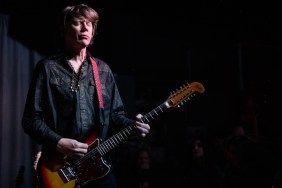Throw an orchestra behind a rock band and everyone’s a fan. The orchestra imbues depth, a grandeur that makes ordinary music just so much more epic. Or does it? Hurricane Transcriptions, an experimental piece by Sonic Youth noise rock legend Lee Ranaldo was a shining example of what happens when you get too big for people to tell you when your ideas are shite.
It began with a crescendo so slight as to be barely perceptible to the human ear. The initial roll on the percussionist’s gong was given away by the movement of hands more than the sound itself. Roland Peelman conducted the Ensemble Offspring without time, his hands moving with the grace and fluidness of a mantis. Cellos punctuated the swelling tide with sharp staccato, a brisk introduction to quivering strings and bowed cowbell. Violins like rusty swings swiftly slipped in as we waited for the hurricane to come.
Finally we heard that to which all the grandiosity had been building. Ranaldo’s acoustic guitar severed this swirling orchestra with a country lilt that came across as, well, pathetic. Add to this some horrific vocal intonation and a mic sound that should have seen the engineer shot in the head, and you couldn’t help but be horribly dismayed by the tragedy that befell the orchestra the minute the rock legend opened his mouth. This preceded yet more jarring transitions.
Somehow, despite the fact that the rather extraordinary orchestral arrangement had been entirely composed by Ranaldo, one of the great guitarists of our time was coming across as an amateur. In short, the audience was treated to a haunting and deeply moving film, interrupted by some unfortunate ad breaks that just happened to be the artist’s songs.
Following Ranaldo’s conclusion, the opening of Luciano Berio’s Laborintus II couldn’t help but make you feel like you were in a school hall watching end-of-year shows by the academy’s best students. The student was Mike Patton and everyone knew he was the school prodigy. You could tell by the way he walked onto the stage, score under arm, sitting so calmly, his mic held like a cigarette in the left hand. What followed was a flawless example of how one heads an orchestra.
First, you tear its parts into an exquisite, disarrayed cacophony, then you have it put itself together again piece by piece, until instruments and voices, in growing multiples of speckled sound, form a ravenous sound-bed. Finally, you rise, until with megaphone in hand, your tirade of maniacal Italian screams leads the ensemble irresistibly in pursuit of you.
Most interesting about the piece was the fact that, while it was not written or even led by Patton, it felt like it could have been. We sat in Patton’s absurdist opera of screams, in a world that would make Luigi Russolo dance with glee, and with it, The Art of Noises was momentarily lifted from the dusty shelves of academia and hurtled passionately back into the public domain.
With Patton at the helm, a miracle occurred: high art was embraced simply because some rock fans would pay anything to hear their hero scream. Put the two acts together? You just witnessed an American get schooled by a countryman who decided that being Italian is better.











